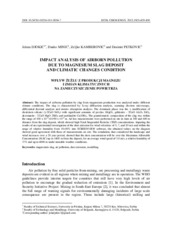Impact analysis of airborn pollution due to magnesium slag deposit and climatic changes condition
Апстракт
The impact of airborne pollution by slag from magnesium production was analyzed under different climate conditions. The slag is characterized by X-ray diffraction analysis, scanning electron microscopy, differential thermal analysis and atomic absorption analysis. The dominant phase was the gamma modification of dicalcium silicate (gamma-2CaO SiO2) with significant amounts of perclas (MgO), gehlenite - 2CaO Al2O3 SiO2, akermanite - 2CaO MgO 2SiO(2) and portlandite Ca(OH)(2). The granulometric composition of the slag was within the range of 100 x 10(-3)divided by 0.090 x 10(-3) m. Ad hoc measurements were performed on site in June at 300 and 600 m distance from the slag deposit, which showed high Total Suspended Particles (TSP) concentrations. Imputing the results of an experimental investigation of the dust emission for wind velocities of 5, 7, and 10 m/s and within the range of relative humidity from 10 divided by 50% into SCREENVIEW software, the obtained values on the diagram showed... good agreement with those of measurements on site. The simulation, that considered the landscape and wind increases over a 20 year period, showed that the dust concentration will be over the Maximum Allowable Concentration (MAC) up to 1400 m from the deposit, for an average wind speed of 3.0 m/s, a relative humidity of 37% and up to 4000 m under unstable weather conditions.
Кључне речи:
magnesium slag / air pollution / dust emission / modellingИзвор:
Ecological Chemistry and Engineering S-Chemia I Inzynieria Ekologiczna S, 2012, 19, 3, 439-450Издавач:
- Soc Ecological Chemistry & Engineering, Opole
Финансирање / пројекти:
- Истраживање климатских промена и њиховог утицаја на животну средину - праћење утицаја, адаптација и ублажавање (RS-MESTD-Integrated and Interdisciplinary Research (IIR or III)-43007)
DOI: 10.2478/v10216-011-0034-7
ISSN: 1898-6196
WoS: 000307645200013
Scopus: 2-s2.0-84864140025
Институција/група
Tehnološko-metalurški fakultetTY - JOUR AU - Đokić, Jelena AU - Minić, Duško AU - Kamberović, Željko AU - Petković, Desimir PY - 2012 UR - http://TechnoRep.tmf.bg.ac.rs/handle/123456789/2111 AB - The impact of airborne pollution by slag from magnesium production was analyzed under different climate conditions. The slag is characterized by X-ray diffraction analysis, scanning electron microscopy, differential thermal analysis and atomic absorption analysis. The dominant phase was the gamma modification of dicalcium silicate (gamma-2CaO SiO2) with significant amounts of perclas (MgO), gehlenite - 2CaO Al2O3 SiO2, akermanite - 2CaO MgO 2SiO(2) and portlandite Ca(OH)(2). The granulometric composition of the slag was within the range of 100 x 10(-3)divided by 0.090 x 10(-3) m. Ad hoc measurements were performed on site in June at 300 and 600 m distance from the slag deposit, which showed high Total Suspended Particles (TSP) concentrations. Imputing the results of an experimental investigation of the dust emission for wind velocities of 5, 7, and 10 m/s and within the range of relative humidity from 10 divided by 50% into SCREENVIEW software, the obtained values on the diagram showed good agreement with those of measurements on site. The simulation, that considered the landscape and wind increases over a 20 year period, showed that the dust concentration will be over the Maximum Allowable Concentration (MAC) up to 1400 m from the deposit, for an average wind speed of 3.0 m/s, a relative humidity of 37% and up to 4000 m under unstable weather conditions. PB - Soc Ecological Chemistry & Engineering, Opole T2 - Ecological Chemistry and Engineering S-Chemia I Inzynieria Ekologiczna S T1 - Impact analysis of airborn pollution due to magnesium slag deposit and climatic changes condition EP - 450 IS - 3 SP - 439 VL - 19 DO - 10.2478/v10216-011-0034-7 ER -
@article{
author = "Đokić, Jelena and Minić, Duško and Kamberović, Željko and Petković, Desimir",
year = "2012",
abstract = "The impact of airborne pollution by slag from magnesium production was analyzed under different climate conditions. The slag is characterized by X-ray diffraction analysis, scanning electron microscopy, differential thermal analysis and atomic absorption analysis. The dominant phase was the gamma modification of dicalcium silicate (gamma-2CaO SiO2) with significant amounts of perclas (MgO), gehlenite - 2CaO Al2O3 SiO2, akermanite - 2CaO MgO 2SiO(2) and portlandite Ca(OH)(2). The granulometric composition of the slag was within the range of 100 x 10(-3)divided by 0.090 x 10(-3) m. Ad hoc measurements were performed on site in June at 300 and 600 m distance from the slag deposit, which showed high Total Suspended Particles (TSP) concentrations. Imputing the results of an experimental investigation of the dust emission for wind velocities of 5, 7, and 10 m/s and within the range of relative humidity from 10 divided by 50% into SCREENVIEW software, the obtained values on the diagram showed good agreement with those of measurements on site. The simulation, that considered the landscape and wind increases over a 20 year period, showed that the dust concentration will be over the Maximum Allowable Concentration (MAC) up to 1400 m from the deposit, for an average wind speed of 3.0 m/s, a relative humidity of 37% and up to 4000 m under unstable weather conditions.",
publisher = "Soc Ecological Chemistry & Engineering, Opole",
journal = "Ecological Chemistry and Engineering S-Chemia I Inzynieria Ekologiczna S",
title = "Impact analysis of airborn pollution due to magnesium slag deposit and climatic changes condition",
pages = "450-439",
number = "3",
volume = "19",
doi = "10.2478/v10216-011-0034-7"
}
Đokić, J., Minić, D., Kamberović, Ž.,& Petković, D.. (2012). Impact analysis of airborn pollution due to magnesium slag deposit and climatic changes condition. in Ecological Chemistry and Engineering S-Chemia I Inzynieria Ekologiczna S Soc Ecological Chemistry & Engineering, Opole., 19(3), 439-450. https://doi.org/10.2478/v10216-011-0034-7
Đokić J, Minić D, Kamberović Ž, Petković D. Impact analysis of airborn pollution due to magnesium slag deposit and climatic changes condition. in Ecological Chemistry and Engineering S-Chemia I Inzynieria Ekologiczna S. 2012;19(3):439-450. doi:10.2478/v10216-011-0034-7 .
Đokić, Jelena, Minić, Duško, Kamberović, Željko, Petković, Desimir, "Impact analysis of airborn pollution due to magnesium slag deposit and climatic changes condition" in Ecological Chemistry and Engineering S-Chemia I Inzynieria Ekologiczna S, 19, no. 3 (2012):439-450, https://doi.org/10.2478/v10216-011-0034-7 . .



